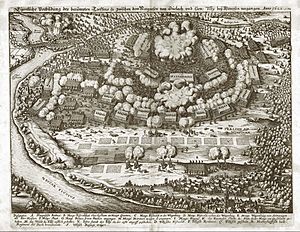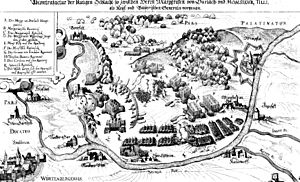Battle of Wimpfen facts for kids
Quick facts for kids Battle of Wimpfen |
|||||||
|---|---|---|---|---|---|---|---|
| Part of the Palatinate phase of the Thirty Years' War | |||||||
 Battle of Wimpfen, painting by S. Vrancx showing the magazine explosion |
|||||||
|
|||||||
| Belligerents | |||||||
Catholic League |
|||||||
| Commanders and leaders | |||||||
| Strength | |||||||
|
12,700 Two 60-pounder guns, one 70-pounder, 20 of a mixture of 3-, 5-, 6-, and 8-pounders, 6 "newly cast' guns, and 9 half culverins |
Approx: 15,650+ 8,700 infantry, 900 cavalry, seven 12 pounders, and 1 half culverin with Tilly. 5,200 infantry, 850 cavalry, and five 8-pounders with Spanish. |
||||||
| Casualties and losses | |||||||
| 3,000+ | 1,800+ | ||||||
The Battle of Wimpfen was an important fight during the Thirty Years' War. It happened on May 6, 1622, near the town of Wimpfen in what is now Germany. This battle was part of a larger conflict called the Palatinate campaign.
In this battle, the combined armies of the Catholic League and the Spanish Empire won a big victory. Their leaders were General Tilly and General Gonzalo de Córdoba. They fought against the Protestant forces led by Georg Friedrich, Margrave of Baden.
Contents
What Led to the Battle?
The Start of the Thirty Years' War
The Thirty Years' War began with the Bohemian Revolt. This happened when the Protestant nobles in Bohemia (a region in today's Czech Republic) refused to accept Ferdinand II as their Catholic king. Instead, they chose a Protestant leader, Frederick V of the Palatinate, to be their king in 1619.
However, Frederick V's rule didn't last long. In 1620, Catholic League troops, led by General Tilly, defeated the Protestants at the Battle of the White Mountain. This loss meant Frederick V lost his kingdom.
At first, many Protestant princes in Germany didn't join the fight. They signed a peace agreement called the Treaty of Ulm in 1620 and later broke up their alliance, the Protestant Union.
Fighting in the Palatinate
Even though the Protestant Union had dissolved, some Protestant leaders still had their own armies. One such leader was Count Georg Friedrich, Margrave of Baden. He had kept his army of hired soldiers.
In April 1622, General Tilly moved his Catholic League army towards the Electoral Palatinate. This region was important to Frederick V. Seeing this, Georg Friedrich decided to join Frederick's cause. He marched his army to meet another Protestant general, Ernst von Mansfeld. They met shortly after Mansfeld had won a battle against Tilly at Battle of Mingolsheim on April 27.
By early May, another Protestant army, led by Christian of Brunswick, arrived north of the Neckar River. They were ready to help their fellow Protestants. General Mansfeld crossed the Neckar River to join Brunswick and planned to attack a Spanish army base. Meanwhile, Georg Friedrich chased Tilly's army, which was moving east towards Wimpfen. What Georg Friedrich didn't know was that a Spanish army, led by General Córdoba, had joined Tilly's forces. This made the Catholic army much stronger.
On May 5, the Protestant troops arrived from the southwest. They crossed a small creek called Böllinger Bach and got ready for battle.
The Battle of Wimpfen
The battle started early on May 6. Both sides tried to attack each other but didn't succeed. This went on until about 11 o'clock in the morning.
Both armies had built strong defenses using wagons, known as a wagenburg. They also had many cannons. This made both sides careful about attacking. General Tilly kept Córdoba's Spanish troops in reserve at first. He was worried that other Protestant armies might attack. But no other attacks came.
Even as parts of the Catholic army began to struggle, Tilly's best soldiers held their ground. They formed a tight group with long spears, which scared away Georg Friedrich's cavalry (soldiers on horseback).
There was a quiet period in the fighting until early afternoon. Then, a Catholic attack on Georg Friedrich's right side caused his cavalry to run away. Around six o'clock in the evening, a cannonball hit the Protestant army's gunpowder storage. This caused a huge explosion, creating panic among their soldiers. Soon after, their wagon fort defense fell to the Catholic attacks. Many Protestant soldiers died trying to escape across the Böllinger Bach creek.
What Happened Next?
Count Georg Friedrich was hurt in the face during the battle. He barely managed to escape to Stuttgart. There, he gave up his title and power to his oldest son, Frederick V. However, this didn't protect his family from punishment. Catholic troops completely destroyed his lands. In August, a large part of his territory was given to William, Margrave of Baden-Baden. William belonged to a rival, Catholic branch of the Baden family. Because of this, the region was split into Protestant Baden-Durlach and Catholic Baden-Baden until 1771.
General Tilly continued his military campaign. He won another battle at the Battle of Höchst in June. After that, he captured the strong towns in the Electoral Palatinate one by one.
In 1623, a meeting called the Diet of Regensburg took place. At this meeting, Frederick V's lands and his important position in the Electoral College were given to Duke Maximilian of Bavaria. Maximilian was a very important leader of the Catholic League. From 1623 onwards, he was known as Maximilian I, Elector of Bavaria, and his duchy became the Electorate of Bavaria.
See also
 In Spanish: Batalla de Wimpfen para niños
In Spanish: Batalla de Wimpfen para niños



